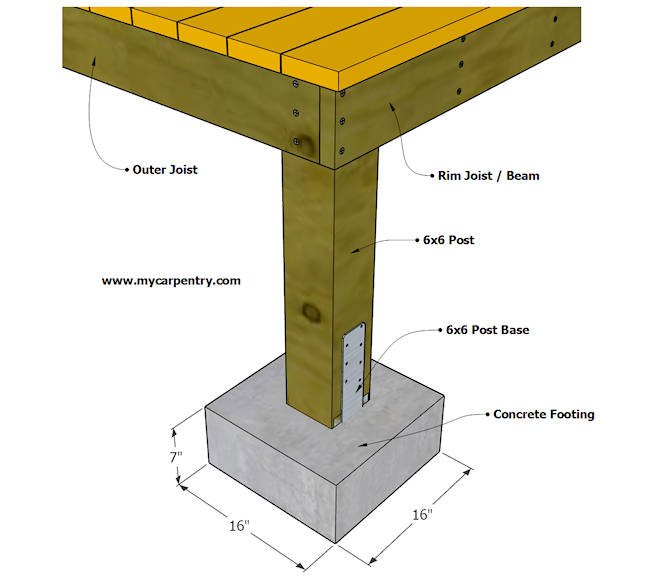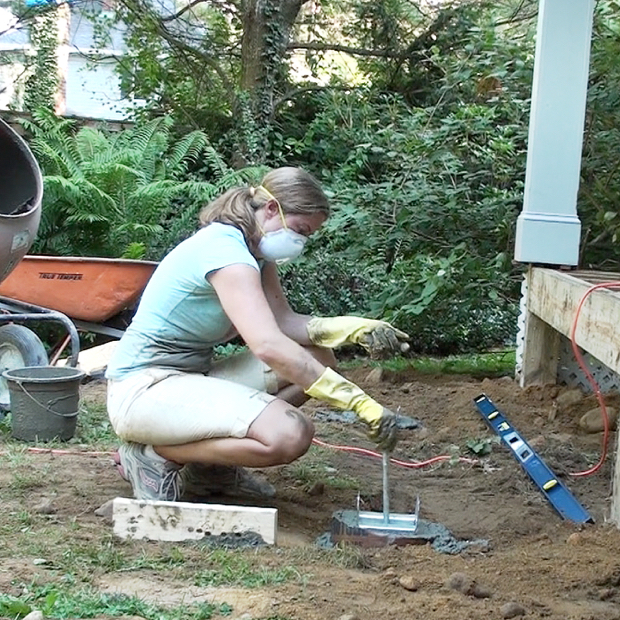From Principle to Concrete: The Crucial Duty of Deck Footings in Sturdy and Safe Decks
Wiki Article
Selecting the Right Deck Footings for Security and Longevity
The longevity and safety and security of your deck depend heavily on the type of footings you choose, as they offer the essential support and stability to withstand the test of time. In this conversation, we will check out the various types of deck grounds, think about the important elements to consider when making a decision, and delve right into the pros and disadvantages of different alternatives.Sorts Of Deck Footings
There are numerous types of deck footings that can be made use of, each offering one-of-a-kind benefits and considerations. One usual kind of footing is the concrete pier ground. These footings consist of a cylindrical opening loaded with concrete, which supplies a strong foundation for the deck messages. Concrete pier grounds are fairly easy to set up and provide exceptional stability, making them a prominent choice for many deck jobs.These grounds are set up by screwing them right into the ground, which produces a protected structure for the deck. They additionally enable for easy change and progressing of the deck if required.
Additionally, some contractors choose precast concrete footings. These footings are made from sturdy concrete and be available in numerous sizes and shapes to fit various deck layouts. Precast concrete grounds are hassle-free to install and provide a stable base for the deck structure.
Ultimately, another alternative is the post-in-anchor footing system. This sort of footing includes driving a steel anchor into the ground and attaching it to the deck article. It offers flexibility in regards to placing the deck messages and appropriates for decks with light-weight structures.
When picking the best type of deck footing, it is necessary to consider variables such as dirt problems, deck tons, and regional building codes (Deck Footings). Consulting with a professional contractor or architectural engineer can aid ensure the ideal ground is picked for a secure and stable deck
Factors to Consider When Choosing Footings
When choosing the suitable grounds for a deck, it is critical to carefully consider various variables such as dirt problems, deck lots, and adherence to local structure codes. These variables play a significant role in guaranteeing the security and longevity of the deck structure.The kind of dirt on which the deck will certainly be developed determines the type of footings needed. On the other hand, decks constructed on clay or expansive soils might call for footings that can accommodate the dirt's tendency to expand and contract.
One more important factor is the deck lots. The weight of the deck, consisting of the materials utilized and any kind of prospective live tons such as furnishings or celebrations, have to be considered when selecting grounds. The footings should be made to bear the weight of the deck and disperse it uniformly to prevent any kind of architectural concerns or failings.
Finally, adherence to regional building regulations is vital. Building codes differ from region to area, and it is vital to abide by the specific demands set by the regional authorities. Deck Footings. These codes make sure that the deck is built securely and meets the required criteria for architectural stability and load-bearing ability
Concrete Grounds: Disadvantages and pros

Concrete footings offer a number of benefits and drawbacks when utilized as discover this the structure for a deck. On the positive side, concrete footings give excellent security and longevity.
One more benefit of concrete grounds is their convenience. They can be poured into different shapes and dimensions to accommodate numerous deck styles and configurations. Concrete grounds can be customized to fit the details demands and requirements of the deck framework.
However, there are likewise some drawbacks to using concrete footings. One major negative aspect is the cost and labor associated with their installment. Concrete grounds require excavation and often require the help of hefty machinery. This can enhance the overall cost of the deck job and might require specialist help.

Helical Piers Vs. Sonotubes: Which Is Much better?
In thinking about the structure alternatives for a deck, the comparison between helical piers and sonotubes is crucial in determining the premium option. Helical piers, likewise called screw stacks, are steel shafts with helical plates connected to them. They are twisted into the ground utilizing hydraulic equipment, offering a long lasting and secure foundation for the deck. On the various other hand, sonotubes are round kinds made of cardboard or fiber material that are loaded with concrete. They are put in an opening dug right into the ground and supply support for the deck.The helical plates on the piers produce a solid Check Out Your URL grasp with the soil, changing or protecting against any kind of activity of the deck. Sonotubes, on the various other hand, count solely on the concrete filling for stability, which may not use the same level of strength and resistance.
In regards to installment, helical piers are relatively less complicated and faster to install compared to sonotubes. The hydraulic equipment utilized to twist the piers into the ground makes certain a effective and quick process. Sonotubes, on the various other hand, need digging holes and putting concrete, which can be time-consuming and labor-intensive.
In addition, helical piers are an even more flexible alternative. If required, they can be used in different soil conditions and can be changed or strengthened. Sonotubes, on the other hand, may call for additional assistance, such as rebar, in particular soil problems or locations with high tons requirements.
Choosing the Right Footings for Your Deck's Dimensions
For optimum structural integrity, it is important to very carefully pick the appropriate grounds that align with the dimensions of your deck. The dimensions of your deck, including its size, height, and size, play a considerable duty in figuring out the type and dimension of grounds required.When picking footings for your deck, it is necessary to take into consideration the load-bearing ability of the dirt. The weight of the deck, combined with the weight of any kind of furnishings or people on it, exerts a significant force on the footings (Deck Footings). For that reason, it is critical to select footings that can effectively support this weight without sinking or moving with time.
The shapes and size of the grounds ought to likewise be taken into consideration. Larger decks with better measurements need larger grounds to offer sufficient security and support. The form of the grounds, whether they are square or rounded, relies on the design and layout of the deck. Furthermore, the depth at which the footings are installed ought to be established based on the frost line in your area to avoid any kind of heaving or moving as a result of freezing temperatures.
Conclusion
In conclusion, selecting the right deck grounds is crucial for making sure stability and toughness. Aspects such as the type of grounds, the deck's dimensions, and the pros and cons of various choices should be thought about.These grounds are composed of a cylindrical opening loaded with concrete, which supplies a strong foundation for the deck blog posts. Concrete pier grounds are relatively easy to mount and provide superb stability, making them a preferred choice for numerous deck jobs.
Precast concrete footings are hassle-free to install and give a stable base for the deck structure.
It uses versatility in terms check it out of placing the deck blog posts and is ideal for decks with light-weight frameworks.
Concrete footings use several advantages and downsides when used as the foundation for a deck.
Report this wiki page